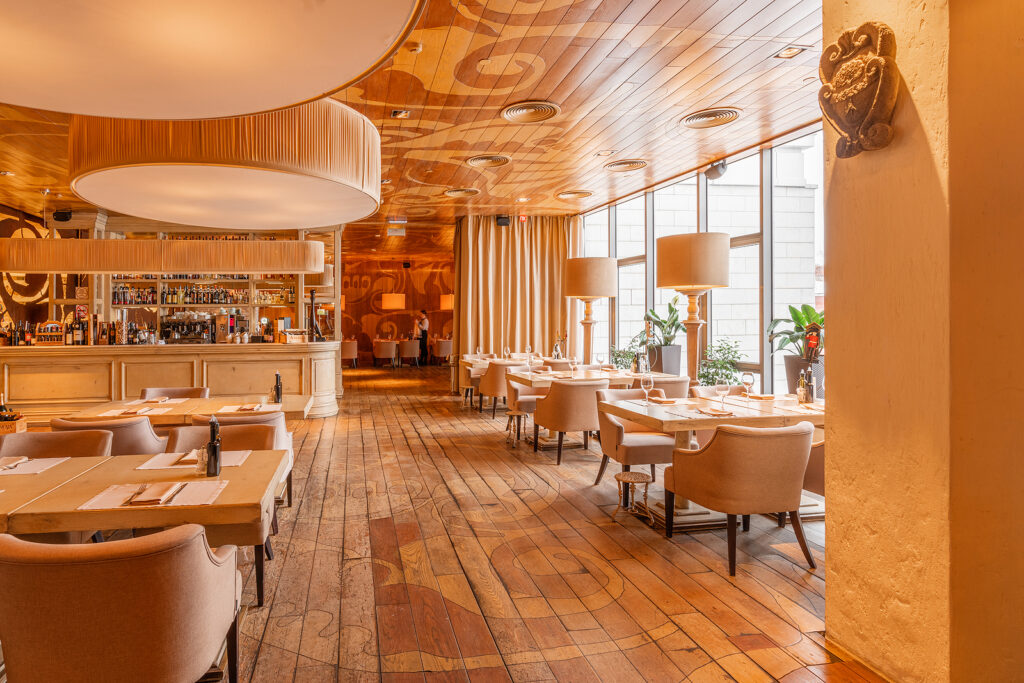Opening a restaurant feels like stepping into a dream—but without proper planning, that dream can quickly become overwhelming. Restaurant build-outs represent one of the most significant investments you’ll make, often determining whether your venture thrives or struggles from day one.
As such, successful restaurant build-outs don’t happen by accident. They’re the result of methodical planning, careful budgeting, and understanding the complex web of regulations, design principles, and construction realities that define commercial restaurant construction. Whether you’re opening your first location or planning a restaurant remodel, the foundation you build through thorough preparation will support your business for years to come.
This guide walks you through every critical phase of restaurant build-out planning, from initial concept development to grand opening. You’ll discover how to avoid costly mistakes, navigate regulatory requirements, and create a space that serves both your operational needs and customer experience goals.

Restaurant Build-Out 101
Initial Planning and Concept Development
Define Your Restaurant Concept
Before breaking ground on any restaurant construction project, successful owners invest significant time developing a crystal-clear concept. Your restaurant concept serves as the blueprint for every subsequent decision, from equipment selection to interior design choices.
Identify Your Target Audience
Start by defining your target audience with surgical precision. Are you serving busy professionals seeking quick, healthy lunches? Families looking for casual dining experiences? Understanding your customer base directly influences location requirements, menu development, and space design. A fast-casual concept requires different kitchen workflows and seating arrangements compared to an upscale dining establishment.
Build Your Menu and Business Plan
Menu development runs parallel to concept creation and significantly impacts your build-out requirements. A pizza-focused restaurant demands different ventilation systems, oven specifications, and storage needs than a sushi bar. Document your core menu items early in the planning process, as these decisions will guide equipment purchases, kitchen layout design, and utility requirements.
Create a detailed business plan that extends beyond financial projections. Include operational workflows, staffing requirements, and service models. These elements directly influence your space design and construction needs. A restaurant planning table service requires different traffic flow patterns than one focusing on takeout and delivery.
Budgeting and Funding Your Restaurant Build-Out
Break Down Costs
Restaurant build-outs demand substantial financial investment, typically ranging from $175 to $750 per square foot, depending on concept complexity and location requirements. Creating a realistic budget requires breaking down costs into categories: construction, equipment, permits, professional services, and contingency funds.
Construction costs often represent the largest expense category, encompassing everything from demolition and electrical work to plumbing and HVAC installation. Commercial build-outs frequently require extensive infrastructure updates to support restaurant operations, particularly in older buildings not originally designed for food service.
Equipment expenses vary dramatically based on your concept. A basic coffee shop might require $50,000 in equipment, while a full-service restaurant with extensive kitchen operations could need $200,000 or more. Include both kitchen equipment and front-of-house necessities like POS systems, furniture, and sound systems in your calculations.
Plan for Contingencies
Always include a contingency fund of at least 20% above your projected costs. Restaurant renovations commonly uncover unexpected issues—outdated electrical systems, plumbing problems, or structural modifications—that can significantly impact budgets. Experienced restaurateurs often recommend budgeting 25-30% contingency for older buildings.
Explore Funding Options
Explore multiple funding options early in your planning process. Traditional bank loans, SBA financing, investor partnerships, and equipment financing each offer different advantages. Secure funding commitments before beginning construction, as cash flow gaps during build-out can force costly delays or compromises.
Consult a Restaurant Build-Out Expert Today! 🥗
Location, Location, Location
Research Market and Demographics
Location selection represents one of your most critical decisions, directly impacting both build-out requirements and long-term success. The right location aligns with your target demographic, offers appropriate visibility and accessibility, and provides the infrastructure necessary to support your operations.
Conduct thorough market research before committing to any location. Analyze foot traffic patterns, competitor density, parking availability, and demographic data. A location that seems perfect on first impression might reveal significant challenges upon deeper investigation—insufficient parking, zoning restrictions, or infrastructure limitations that increase build-out complexity.
Evaluate the Space
Evaluate the existing space’s condition and suitability for restaurant use. Former restaurant locations often offer advantages like existing grease traps, appropriate electrical capacity, and proper ventilation infrastructure. However, spaces originally designed for other purposes may require extensive modifications to meet restaurant operational needs and health department requirements.
Negotiate Lease Terms
Negotiate lease terms that account for build-out timelines and potential delays. Include provisions for rent abatement during construction periods and ensure your lease allows sufficient time for permitting, construction, and opening preparations. Many landlords offer tenant improvement allowances that can offset build-out costs, particularly in competitive commercial markets.
Design and Layout Optimization
Effective restaurant design balances operational efficiency with customer experience, creating spaces that support smooth workflows while providing appealing environments for diners. Your layout decisions directly impact labor costs, service quality, and revenue potential.
Optimize Kitchen Design
Kitchen design requires particular attention to workflow optimization. Design your kitchen following the “work triangle” principle, minimizing distances between preparation, cooking, and service areas. Consider your menu requirements, expected volume, and staffing levels when determining equipment placement and workspace allocation.
Layout for Customer Comfort
Dining area layout significantly influences customer comfort and revenue optimization. Allow adequate space between tables for comfortable service while maximizing seating capacity. Consider different party sizes and dining occasions when planning table configurations. Bar seating can provide additional revenue opportunities while creating dynamic visual interest.
Plan for Flexibility and Acoustics
Don’t overlook acoustic considerations in your design planning. Hard surfaces common in restaurant construction—tile floors, exposed ceilings, large windows—can create noise levels that negatively impact dining experiences. Incorporate sound-absorbing materials and design elements to maintain comfortable conversation levels.
Plan for future flexibility in your design. Restaurant concepts evolve, and your space should accommodate potential menu changes, service model adjustments, or expansion opportunities. Modular design elements and flexible infrastructure can support future modifications without requiring complete reconstruction.
Navigating Permits and Regulations
Understand Permitting Requirements
Restaurant construction involves navigating complex regulatory requirements at local, state, and federal levels. In Indiana, for example, restaurant construction requires multiple permits and inspections, including construction permits, zoning approvals, and food service sanitation licenses.
Ensure ADA and Fire Safety Compliance
ADA compliance represents a critical consideration that affects both design and construction elements. Fire safety regulations require careful attention during design and construction phases. Install appropriate fire suppression systems, emergency exits, and safety equipment according to local fire codes.
Health Department Approval
Health department approvals require specific attention to kitchen design, ventilation systems, plumbing configurations, and food storage areas. Review health department requirements before finalizing kitchen layouts, as modifications after construction begins can prove extremely expensive.
Construction and Build-Out Management
Choose Experienced Contractors
Successful restaurant construction requires careful contractor selection and diligent project management. Your contractor choice significantly impacts project quality, timeline adherence, and final costs.
Research potential contractors thoroughly, focusing on those with specific restaurant construction experience. Restaurant build-outs involve specialized requirements—commercial kitchen ventilation, grease trap installation, and specialized electrical needs—some of which general contractors may not fully understand. Request references from recent restaurant projects and visit completed locations when possible.
Establish clear communication protocols with your construction team. Schedule regular progress meetings, require detailed progress reports, and maintain open channels for addressing concerns quickly. Poor communication during construction often leads to costly mistakes and timeline delays.
Monitor Progress and Communicate
Monitor your project timeline closely while remaining flexible for necessary adjustments. Weather, permit delays, and unexpected complications can impact schedules. Build buffer time into your opening timeline to accommodate potential delays without jeopardizing your launch plans.
Conduct thorough inspections throughout the construction process rather than waiting until completion. Early identification of issues allows for corrections while solutions remain less expensive and disruptive.
Get Expert Commercial Build-Out Advice ✨
Essential Equipment Considerations
Equipment selection directly impacts both your initial investment and ongoing operational efficiency. Choose equipment that supports your menu requirements while providing reliability and energy efficiency for long-term cost management.
Invest in Reliable Kitchen Equipment
Commercial kitchen equipment represents your largest equipment investment. Ovens, stoves, refrigerators, freezers, and dishwashers must handle your expected volume while meeting health department requirements. Energy-efficient equipment may cost more initially but provides significant savings over time through reduced utility costs.
Modernize Your POS System
Modern POS systems extend far beyond simple payment processing. Today’s systems manage inventory tracking, customer relationship management, staff scheduling, and detailed sales analytics. Choose a system that can grow with your business and integrate with other operational tools.
Prioritize Ventilation and Bar Systems
Proper ventilation and hood systems are non-negotiable for restaurant operations. These systems must meet health code requirements while effectively managing smoke, heat, and odors. Inadequate ventilation can result in health department violations and create uncomfortable dining environments.
Don’t overlook bar equipment if your concept includes alcohol service. Ice machines, glass washers, and draft beer systems require specific installation requirements and ongoing maintenance considerations.
Restaurant Build-Out Planning Checklist
Use this comprehensive checklist to ensure you address every critical aspect of your restaurant build-out:
Concept and Planning:
☐ Define restaurant concept and target audience
☐ Develop detailed business plan
☐ Create realistic budget with contingency
☐ Secure funding (loans, investors, etc.)
Location and Research:
☐ Conduct thorough market research
☐ Select optimal location
☐ Negotiate lease terms
Regulatory and Legal:
☐ Obtain necessary permits and licenses
☐ Ensure ADA standards compliance
☐ Adhere to fire safety regulations
Design and Construction:
☐ Design efficient layout and workflow
☐ Choose reliable contractors
☐ Plan for acoustic management
☐ Schedule regular project updates
Equipment and Systems:
☐ Select appropriate kitchen equipment
☐ Implement modern POS system
☐ Ensure proper ventilation and hood systems
Final Preparations:
☐ Conduct thorough inspections
☐ Establish marketing and pre-launch strategy
☐ Train staff and conduct test runs
☐ Execute grand opening launch plan
RECAP & Key Takeaways
Restaurant build-out planning requires significant time, energy, and financial investment, but thorough preparation pays dividends for years to come. The decisions you make during this critical phase affect everything from daily operational efficiency to customer satisfaction and profitability.
Successful restaurant owners understand that build-out planning extends far beyond construction and decoration. It’s about creating operational systems, regulatory compliance, and customer experiences that support sustainable business growth. The extra time invested in planning prevents costly mistakes and positions your restaurant for success from opening day forward.
Remember that restaurant construction timelines often extend longer than initially expected. Build flexibility into your plans, maintain open communication with all stakeholders, and stay focused on quality over speed. A well-executed build-out creates the foundation for years of successful operations.
The restaurant industry rewards those who plan thoroughly and execute carefully. Your build-out investment represents more than creating a dining space—it’s building the platform for your entrepreneurial dreams and community impact.
Ready to transform your restaurant vision into reality? Consult BAF Corporation for professional guidance through the complex restaurant construction planning process and help you avoid costly mistakes that derail many restaurant ventures.
Related Post: Tips for Finding the Right Restaurant Rental Space in Indianapolis






